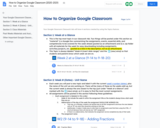
This is a Science Instructional Plan (SIP) that supports the Science Standards of Learning.
- Subject:
- Force/Motion/Energy
- Science
- Material Type:
- Lesson
- Lesson Plan
- Author:
- Myra Thayer
- Anne Petersen
- Gregory MacDougall
- Date Added:
- 01/27/2021

This is a Science Instructional Plan (SIP) that supports the Science Standards of Learning.

Patrick Hausammann of Clarke developed a handout to help teachers organize their Google Classrooms.

Set students up for programming success by creating a BeeBot anchor chart!These editable instructions will help students identify their role as planner or driver and set clear expectations of how Bee-Bot is used in computer programming. Tips:Introduce Bee-Bot whole classMake sure students understand the importance of the clear (x) button to erase the previous codealways press clear first to signal a new code (like how a capital letter signals the start of a new sentence) Plan the program in developmentally appropriate steps (some students program one step at a time, while others can program to the end goal)Turn the Bee-Bot off and use it as a game piece to write successful algorithmsHave students write their plan, or algorithm, on a whiteboard instead of using the cardsThe Bee-Bot emulator is perfect for guided practice!

Students will be introduced to the term algorithm while reading the story of Humpty Dumpty. Students will develop an algorithm or step by step sequence of instructions for putting Humpty Dumpty back together again.

Single step and two-step practical problems involving addition and subtractionMathematics Instructional Plans (MIPs) help teachers align instruction with the Mathematics Standards of Learning (SOL) by providing examples of how the knowledge, skills and processes found in the SOL and curriculum framework can be presented to students in the classroom.

English Instructional Plan – Identifying Denotation and Connotation 7-8

English Instructional Plan – Identifying Figurative Language Grade 5

English Instructional Plan – Identifying Text Features in Nonfiction Grades K-2

English Instructional Plan- Identifying Theme Grades 2-3

English Instructional Plan- Identifying theme and lessons learned Grades 4-5

Determining whether a proportional relationship exists between two quantities and making connections between and among representations of a proportional relationship Mathematics Instructional Plans (MIPs) help teachers align instruction with the Mathematics Standards of Learning (SOL) by providing examples of how the knowledge, skills and processes found in the SOL and curriculum framework can be presented to students in the classroom.

English Instructional Plan – Identifying the Main Idea Grades 1-2

Recognize and use inverse relationships to solve problemsMathematics Instructional Plans (MIPs) help teachers align instruction with the Mathematics Standards of Learning (SOL) by providing examples of how the knowledge, skills and processes found in the SOL and curriculum framework can be presented to students in the classroom.

The students will identify how computing technologies have changed the world and how they are influenced by cultures by group activities, critical activities, problem solving skills and researching.

Identifying independent and dependent variablesMathematics Instructional Plans (MIPs) help teachers align instruction with the Mathematics Standards of Learning (SOL) by providing examples of how the knowledge, skills and processes found in the SOL and curriculum framework can be presented to students in the classroom.


Applying deductive thinkingMathematics Instructional Plans (MIPs) help teachers align instruction with the Mathematics Standards of Learning (SOL) by providing examples of how the knowledge, skills and processes found in the SOL and curriculum framework can be presented to students in the classroom.

Students will learn about innovative light construction and three-dimensional properties while creating their own designs using limited paper materials. Students will be asked to work in teams to brainstorm and create a sculpture that implements light based on their chosen concept.

Students will listen to and/or watch a video about differences across America, listen to or view Ray Charles’ rendition of “America the Beautiful” and then have a choice activity: composing a poem or illustrating verses.

Students will learn about the Pamunkey Indian Tribe in Virginia and the tribe’s history of clay vessels. Students will learn clay hand building methods and hand-build a clay vessel that tells a story.